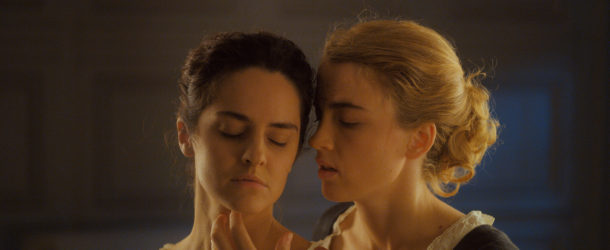As a queer woman, I often find it difficult to find movies that are representative of my experience. A quick browse through Netflix’s LGBTQ+ section shows a list of movies, like Duck Butter and Blue Is the Warmest Color, that tend to miss the nuances of how beautiful a queer love story can be. Rather, they focus on the superficial, spending more time exploring eroticism than a budding love story. Portrait of a Lady on Fire, from the French writer and director Céline Sciamma, offers a welcome change. Set in 18th century Brittany, the film challenges the male gaze to present a thoroughly authentic and human love story.
Unlike Sciamma’s previous movies, like Girlhood and Water Lilies, Portrait isn’t a coming of age story, though she approaches it with equal kindness and care. The story centers on Marianne (Noémie Merlant), a French artist summoned to Brittany by a rich contessa. While there she must paint a portrait of Héloïse, the contessa’s daughter, to send to a possible suitor; if he likes the painting she is to be married to him. The catch is, Marianne must paint in secret; Héloïse (played by Water Lilies star Adèle Haenel) refuses the marriage and refuses to pose. Over the course of just a few days while the contessa is away, Marianna and Héloïse become closer in ways neither could have imagined. With picturesque Brittany as the backdrop to their love story, each shot could be its own Delacroix painting hanging in the Louvre.
I had heard about this movie in August, when it was initially gaining buzz after receiving a standing ovation from audiences at Cannes, where Sciamma won best screenplay. It wasn’t widely released in the United States until Valentine’s Day, so on February 13th I went to a special showing at an arthouse theater on the Upper East Side. The theater was mostly empty, being the night before Valentine’s, and only a few queer couples filled the seats. Once the light dimmed I was enraptured by the movie and by Marianne and Héloïse. For two hours Sciamma and cinematographer Claire Mathon transported me to the rugged cliffs of Brittany. By the end of the film I was sobbing, as was everyone else in the theater. Finally, we seemed to collectively feel, a movie that captures the tenderness and intimacy of a queer romance.
The movie thrives in areas where other queer love stories have fallen short. There are no “oh shit, I’m gay and this will ruin my life moments,” no hate crimes, and no jealous boyfriends. There are no steamy sex scenes, or at least no 10-minute, egregiously drawn-out ones. Rather, the story focuses on equality and everlasting love, and challenges the idea of a muse.
Using what she has referred to as the “female gaze,” Sciamma films the women in a way that is not exploitative but rather shows the passion between them. Her characters are representative of the female artists that have long been forgotten or overlooked because of their gender. We learn more of Marianne’s background in painting, how she is forbidden to paint male subjects for modesty and restricted by the rules and conventions of her time. Héloïse and Marianne are left alone to break these conventions and create a piece of art together. As Héloïse says, while the artist takes in her muse, the muse takes in the artist.
Over the course of the press tour, Sciamma emphasized that she saw the project not just as her own work but as a collaboration between her, Merlant, Haenel, and Mathon. Together they create the masterpiece that is Portrait.


